
In geology and mineralogy, a mineral or mineral species is, broadly speaking, a solid substance with a fairly well-defined chemical composition and a specific crystal structure that occurs naturally in pure form.
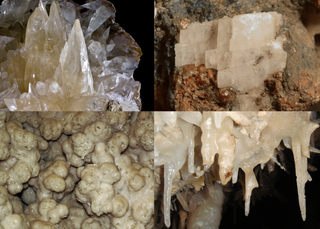
Calcite is a carbonate mineral and the most stable polymorph of calcium carbonate (CaCO3). It is a very common mineral, particularly as a component of limestone. Calcite defines hardness 3 on the Mohs scale of mineral hardness, based on scratch hardness comparison. Large calcite crystals are used in optical equipment, and limestone composed mostly of calcite has numerous uses.
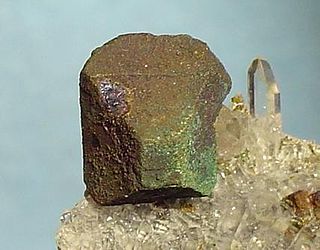
Bornite, also known as peacock ore, is a sulfide mineral with chemical composition Cu5FeS4 that crystallizes in the orthorhombic system (pseudo-cubic).

Dioptase is an intense emerald-green to bluish-green copper cyclosilicate mineral. It is transparent to translucent. Its luster is vitreous to sub-adamantine. Its formula is Cu6Si6O18·6H2O (also reported as CuSiO2(OH)2). It has a hardness of 5, the same as tooth enamel. Its specific gravity is 3.28–3.35, and it has two perfect and one very good cleavage directions. Additionally, dioptase is very fragile, and specimens must be handled with great care. It is a trigonal mineral, forming 6-sided crystals that are terminated by rhombohedra.

Tennantite is a copper arsenic sulfosalt mineral with an ideal formula Cu12As4S13. Due to variable substitution of the copper by iron and zinc the formula is Cu6[Cu4(Fe,Zn)2]As4S13. It is gray-black, steel-gray, iron-gray or black in color. A closely related mineral, tetrahedrite (Cu12Sb4S13) has antimony substituting for arsenic and the two form a solid solution series. The two have very similar properties and is often difficult to distinguish between tennantite and tetrahedrite. Iron, zinc, and silver substitute up to about 15% for the copper site.
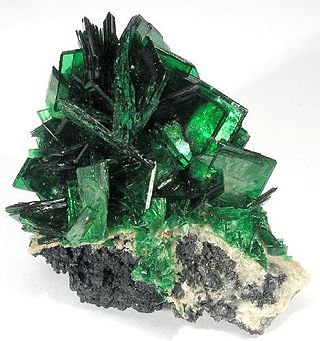
Torbernite, also known as chalcolite, is a relatively common mineral with the chemical formula Cu[(UO2)(PO4)]2(H2O)12. It is a radioactive, hydrated green copper uranyl phosphate, found in granites and other uranium-bearing deposits as a secondary mineral. The chemical formula of torbernite is similar to that of autunite in which a Cu2+ cation replaces a Ca2+ cation. Torbernite tends to dehydrate to metatorbernite with the sum formula Cu[(UO2)(PO4)]2(H2O)8.
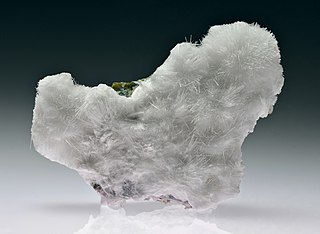
Artinite is a hydrated basic magnesium carbonate mineral with formula: Mg2(CO3)(OH)2·3H2O. It forms white silky monoclinic prismatic crystals that are often in radial arrays or encrustations. It has a Mohs hardness of 2.5 and a specific gravity of 2.
WyartiteCaU5+
(UO
2)
2(CO
3)O
4(OH)·7H2O is a uranium bearing mineral named after Jean Wyart (1902–1992), mineralogist at the Sorbonne, Paris. It has greenish-black, black, or violet-black, translucent to opaque orthorhombic crystals. A hardness of 3 - 4 Mohs. Its other names are Ianthinite (of Bignand), Wyartit and Wyartita. It belongs to the uranium carbonate group of minerals. It is found next to rutherfordine in Shinkolobwe, Shaba, Zaire.
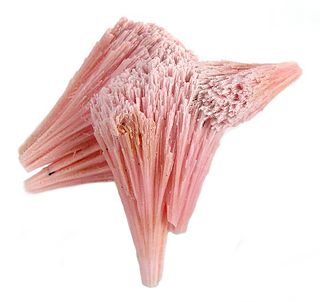
Kutnohorite is a rare calcium manganese carbonate mineral with magnesium and iron that is a member of the dolomite group. It forms a series with dolomite, and with ankerite. The end member formula is CaMn2+(CO3)2, but Mg2+ and Fe2+ commonly substitute for Mn2+, with the manganese content varying from 38% to 84%, so the formula Ca(Mn2+,Mg,Fe2+)(CO3)2 better represents the species. It was named by Professor Bukowsky in 1901 after the type locality of Kutná Hora, Bohemia, in the Czech Republic. It was originally spelt "kutnahorite" but "kutnohorite" is the current IMA-approved spelling.

Carrollite, CuCo2S4, is a sulfide of copper and cobalt, often with substantial substitution of nickel for the metal ions, and a member of the linnaeite group. It is named after the type locality in Carroll County, Maryland, US, at the Patapsco mine, Sykesville.

Penroseite is a rare selenide mineral with formula (Ni,Co,Cu)Se2. It has a gray-steel color and black streak with a hardness of 3. It is an isometric mineral, 2/m3. Penroseite was first discovered in 1925 in a Bolivian rhyolite. It was named for Richard Penrose (1863–1931), an economic geologist.
Cleusonite is a member of the crichtonite group of minerals with the chemical formula (Pb,Sr)(U4+
,U6+
)(Fe2+
,Zn)
2(Ti,Fe2+
,Fe3+
)
18(O,OH)
38. This group of minerals contains approximately thirteen complex metal titanates. The structures of minerals of this group is complicated by frequent fine-scale twinning and metamictization due to radioactive elements. The crichtonite group consists of members of related mineral species of the type A{BC2D6E12}O38 which are characterized by their predominant cations (as seen in crichtonite (Sr), senaite (Pb), davidite (REE + U), landauite (Na), loveringite (Ca), lindsleyite (Ba), and mathiasite (K).
Jolliffeite is a rare selenide mineral with formula NiAsSe or (Ni,Co)AsSe. It is the selenium analogue of the sulfide mineral gersdorffite, NiAsS, with a common impurity of cobalt, CoAsSe. It is named for its discoverer, Alfred Jolliffe, (1907–1988), a Canadian geologist of Queen's University, Kingston, Ontario.

Tyrrellite is a selenide mineral that has a chemical formula of Cu(Co,Ni)2Se4. It has been found in the Goldfields District in northern Saskatchewan, as well as in the Petrovice deposit, Czech Republic. It is named after the Canadian geologist Joseph Burr Tyrrell. Joseph Tyrrell was one of the first geologists from the Geological Survey of Canada to do research in the Goldfields District.

Donnayite-(Y) is a rare-earth carbonate mineral containing the rare-earth metal yttrium. It was first discovered in 1978 at Mont Saint-Hilaire, Quebec. Donnayite was subsequently identified and named after Joseph D. H. Donnay and his wife, Gabrielle Donnay. Both were prominent mineralogists and crystallographers, and J. D. H. Donnay was awarded the Roebling Award by the Mineralogical Society of America in 1971 for his emphasis on the importance of optical mineralogy and crystal morphology. Donnayite tends to occur in small quantities in the pegmatite dykes and miarolitic cavities of mountainous regions. It crystallizes in this environment with increasing alkalinity values until the alkalinity suddenly drops during the last stage of crystallization. This results in increasing amounts of Na carbonates and REE minerals. First discovered at Mont St-Hilaire, donnayite has since been found in the Southern Ural Mountains of Russia and the Narssarssuk pegmatite of South Greenland. Donnayite crystals tend to be small and the color is commonly pale yellow to yellow with a white streak and a vitreous luster. Donnayite crystals usually display trigonal or hexagonal symmetry and have a hardness of 3. Twinning is extremely common in this mineral. Minerals closely related to donnayite include synchysite, calcite, sphalerite, microcline, and analcime. Donnayite is isomorphous with weloganite and mckelveyite.
Chrisstanleyite, Ag2Pd3Se4, is a selenide mineral that crystallizes in high saline, acidic hydrothermal solution at low temperatures as part of selenide vein inclusions in and alongside calcite veins. It tends to be found in assemblages of other selenides: jagueite, naumannite, fischesserite, oosterboschite, and tiemannite, and it is a solid solution mineral with jagueite Cu2Pd3Se4 in which it shares a unique crystal structure that has not been identified elsewhere (Paar et al. 1998; Nickel 2002; Paar et al. 2004). Chrisstanleyite and jagueite are unlike the other minerals of the selenide family as they do not have a sulfide analogue (Topa et al. 2006). First discovered by Werner Paar from a sample received from Hope's Nose, Torquay, Devon, England, chrisstanleyite has since been discovered in the Pilbara region of Western Australia and in El Chire, La Rioja, Argentina. Chrisstanleyite was named after the Deputy Head and Associate Keeper at the Department of Mineralogy at The Natural History Museum in London.
Bijvoetite-(Y) is a very rare rare-earth and uranium mineral with the formula (Y,REE)8(UO2)16(CO3)16O8(OH)8·39H2O. When compared to the original description, the formula of bijvoetite-(Y) was changed in the course of crystal structure redefinition. Bijvoetite-(Y) is an example of natural salts containing both uranium and yttrium, the other examples being kamotoite-(Y) and sejkoraite-(Y). Bijvoetite-(Y) comes from Shinkolobwe deposit in Republic of Congo, which is famous for rare uranium minerals. The other interesting rare-earth-bearing uranium mineral, associated with bijvoetite-(Y), is lepersonnite-(Gd).
Copper selenide is an inorganic binary compound between copper and selenium. The chemical formula depends on the ratio between the two elements, such as CuSe or Cu2Se.

Kruťaite, simplified Krut'aite or krutaite, is a rare mineral with the formula CuSe2. It crystallises in the cubic crystal system. It is part of the pyrite group, being composed of Cu2+ ions and Se22− ions. The mineral is most often found as a dark grey aggregate consisting of tiny crystals no more than a millimeter in size. The crystals are opaque in any size. It has no industrial use, but it is a prized collector's item.

Berzelianite is a rare copper selenide mineral with the formula Cu2Se. It occurs as thin dendritic crusts or as fine-grained inclusions. It crystallizes in the isometric system, unlike its dimorph, bellidoite, which crystallizes in the tetragonal system. The crystals are opaque and slightly malleable.














